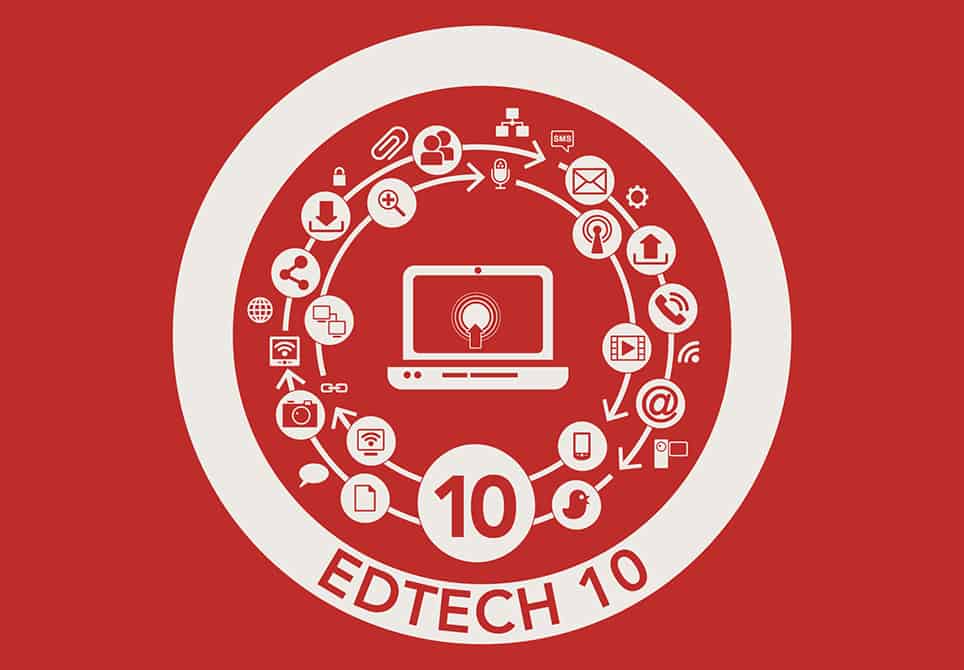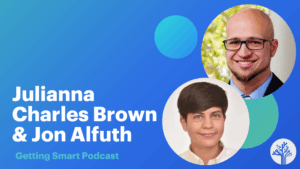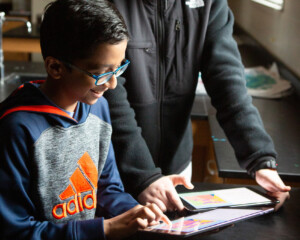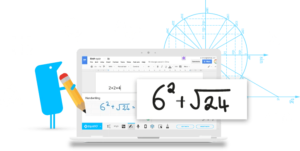EdTech 10: Improving Math Mindsets

April is Math Awareness Month, and regardless of whether or not you feel you are “good at math,” we all know it’s an important skill we all need to encourage today’s students to continuously improve.
So this week’s EdTech 10 contains stories about what’s new in math, from a new math app for teachers and family STEAM night at school, to a video game creation challenge and awareness around college and career readiness for U.S. students.
Blended Schools & Tools
1. Diggin’ digital. The use of digital content is on the rise in American schools–8 out of 10 K-12 schools and districts are using some form of it. It’s primarily being used as classroom curriculum, but also to round out e-book collections in a library or media center. The highest percentage of requests come from English/Language Arts teachers at 74%. Within this category, the primary preference for digital content is informational texts and literary non-fiction aligned to units of study.
#ELA Dominates in K–12 Digital Content Usage https://t.co/1TQuONBzcn @THE_Journal #edtech #ELAChat #blendedlearning
— Carri Schneider (@CarriSchneider) April 6, 2016
Digital Developments
2. Focused on dreams. After partnering with teachers, schools and districts for design ideas, DreamBox just announced the release of AssignFocus®. This feature enables teachers to easily create focused math assignments and differentiate lessons for each student. AssignFocus is designed to leverage its adaptive capabilities to start assigned lessons at the right level of difficulty for each individual student, and continues adapting both during and between lessons. Hopefully this will help change students’ mindsets around their math abilities.
Check out #AssignFocus from @DreamBox_Learn: One assignment, unlimited personalized lessons https://t.co/Cx8LWbE3q7 #EdTech10 #blendedmath
— Megan Mead (@MegMarMe) April 11, 2016
Stem Gems
3. Gamers wanted. Organized by the Joan Ganz Cooney Center at Sesame Workshop, E-Line Media, and founding sponsor the Entertainment Software Association (ESA), the fifth annual National STEM Video Game Challenge is underway. The challenge aims “to motivate interest in science, technology, engineering and math (STEM) among youth by transforming their natural passions for playing video games into designing and creating their own.” U.S. middle and high school students have until August 15 to submit an entry using any game creation platform they choose.
The 5th annual National #STEM Video Game Challenge is on! #Students submit your game ideas: https://t.co/9J1ufAGI3A @RichatESA #EdTech10
— Catherine Wedgwood (@C_Wedgwood) April 11, 2016
4. ASU GSV Summit attendees are invited to listen to and vote for their favorite 2016 Lumina Foundation Social Innovation Prize for Postsecondary Education finalist for a $25,000 award. This year’s three chosen social ventures will share with attendees and a panel of judges how their organization is either already impacting postsecondary education in the US, or why they believe they could apply their model to increase attainment in the higher education sector. At the end, $25,000 will be awarded according to a live crowd vote and $25,000 will be awarded according to the judge’s decision. Come listen to pitches, ask the finalists questions, and help decide who will win on Wednesday, April 20 at 10 a.m. PST.
Who will win the $50,000 @LuminaFound #socialinnovation prize @asugsvsummit next week? Attendess can help decide: https://t.co/ibfu3BMZhk
— Catherine Wedgwood (@C_Wedgwood) April 14, 2016
5. Finding Nemo. Earth Day is April 22, and Discovery Education is helping educators nationwide celebrate with a variety of new resources that support marine science lessons. These new learning tools, reviewed by Discovery Education’s expert curriculum team and aligned to state standards, have been added to Discovery Education’s website as well as its award-winning services: Discovery Education Streaming Plus and the Discovery Education Science Techbook.
Got plans this #EarthDay2016? Why not join us? Register your class at https://t.co/cYJiVmqGdc #science #NSTA16
— Discovery Education (@DiscoveryEd) April 7, 2016
Higher, Deeper, Further, Faster Learning
6. Badgers for the win. Pearson and Capella University are collaborating to issue digital badges for students completing the online university’s National Security Agency (NSA) and Department of Homeland Security designated master’s program. Capella University is one of the first online universities to leverage Pearson’s digital badging platform to signal to employers the professional skills and competencies its students have gained through coursework and certificate programs. We discussed the power of micro-credentialing recently on the blog in this essential educators’ guide to implementing powerful professional learning with micro-credentials.
.@Pearson & @CapellaU partner to issue Digital Badges to #students–connecting #HigherEd to Employability: https://t.co/h5ALHQTPaU #EdTech10
— Jessica Slusser (@Jess_Slusser) April 12, 2016
Policy Pieces
7. Break on through. 42 state legislatures have broken through barriers to provide the flexibility to schools interested in implementing competency-based education. “Over the past 10 years, a lot of the focus has shifted from legislation to actual policy making so that state boards of education and state departments of education have the policy authority that they need to make the changes happen,” said Susan Patrick, president and CEO of iNACOL. Attendee registration is now open for iNACOL’s annual symposium, which is the industry’s leading event for K-12 competency-based, blended and online learning.
Shifting toward #competencyed? Here’s a reading list for #edleaders: https://t.co/BGXldG7jXs #CBE #CBLearning
— iNACOL (@nacol) April 11, 2016
8. PD perfection. Washington legislators and governor Jay Inslee recently signed a bill into law that will help deliver high-quality professional learning to educators. A big thank you from all of us at Getting Smart to Governor Inslee and Representatives Lytton, Magendanz and Bergquist for recognizing the needs for high-quality teacher PD, particularly those strong in STEM subjects that will power student opportunity and the state’s economy.
WA state legislators pass bill to help deliver high quality #profdev #PD https://t.co/UerxGKKEG8 @eschoolnews #Teachers #EdTech10 #EdChat
— Bonnie Lathram (@belathram) April 12, 2016
Research & Reports
9. Exploring CTE. After many decades of neglect and stigma against old-school “vo-tech,” more students are being exposed to high-quality CTE. Fordham’s latest study presents Arkansas data exploring whether students benefit from CTE coursework–more specifically, if they benefit from focused sequences of CTE courses aligned to certain industries. The report’s findings are largely positive: students with greater exposure to CTE are more likely to graduate from high school, enroll in a two-year college, be employed and earn higher wages. Download the full report to learn more and use #CTErevisited to join the Twitter conversation.
The “Bachelor’s degree or bust” strategy isn’t working. High-quality #CTE programs offer another path to success: https://t.co/CtQbC2q1KL
— Carri Schneider (@CarriSchneider) April 7, 2016
10. Are you ready? As we continue creating our GenDIY series around how the next generation is addressing education and career skills in an ever-changing global economy, we can’t help but notice the growing number of reports on the current state of college and career readiness in today’s students:
- EdTrust’s new report, Meandering Toward Graduation: Transcript Outcomes of High School Graduates, shares that 47% of high school graduates are not ready for college or career.
47% of #HighSchool grads not ready for college or career https://t.co/dynt6XLVPM @EdTrust pic.twitter.com/LqrZm4JFYb
— Tom Vander Ark (@tvanderark) April 10, 2016
- The Lumina Foundation released A Stronger Nation 2016, its annual report tracking the nation’s progress toward achieving its Goal 2025 (60% of Americans holding degrees, certificates or other high-quality credentials by the year 2025). The report also raises important questions about the state of our nation’s postsecondary attainment. News release
What is the difference between certificates & certifications? #StrongerNation @LuminaFound #Goal2025
— Lucia Lumina (@LuciaLumina) April 11, 2016
For more see:
- EdTech 10: Paths, Policy, Partnerships and the Planet
- EdTech 10: Going Deep with Deeper Learning
- EdTech 10: Marching On
Stay in-the-know with all things EdTech and innovations in learning by signing up to receive the weekly Smart Update. This post includes mentions of a Getting Smart partner. For a full list of partners, affiliate organizations and all other disclosures please see our Partner page.







0 Comments
Leave a Comment
Your email address will not be published. All fields are required.